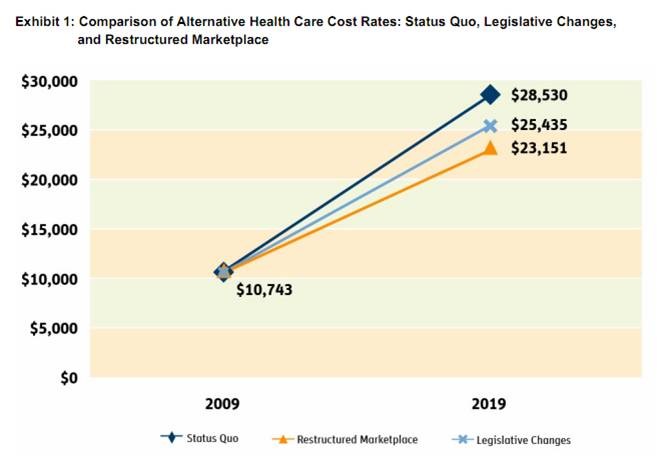The Bottom Line: Families USA “Report” a Misleading Sham
Earlier this week, the liberal advocacy group Families USA released a “report” claiming to provide “the bottom line” costs and benefits of Obamacare to American families (including state-by-state analyses, which are being released over the next two weeks). I was tempted not to dignify the report with an answer, but several press stories about it prompted me to reconsider, as these myths tend to linger if not immediately rebutted. The bottom line about the “bottom line” report is that it doesn’t attempt to spin the facts surrounding rising premiums and costs so much as it attempts to hide them entirely (although it includes plenty of spin too). Here are four reasons why:
- Modeling for the report was completed by Jonathan Gruber, who was a paid – though undisclosed – consultant on Obamacare itself. When the controversy surrounding his previously undisclosed Administration contracts arose last year, Gruber alleged that he informed reporters of his paid consultancy “whenever they asked” – but that fact is not referenced anywhere in the report. Yet nowhere in the report do Families USA and Gruber disclose the fact that the math behind the report was done by a paid consultant to the Obama Administration.
- The spin behind the report’s methodology can be found on page 11 of the national report:
The Commonwealth Fund reviewed relevant literature published by several teams of economists that looked at the health care system reforms in the Affordable Care Act as it was developed in Congress. They reported that a 1.5 percentage point reduction in cost increases annually is realistic. While many of the cost and quality provisions in the Affordable Care Act started last year or this year, some will not be in place until 2014. Therefore, for our analysis, Families USA based our modeling on the Commonwealth Fund report’s most conservative cost reduction assumption of only 1.0 percentage point per year starting in 2014. We believe this assumption is reasonable and defensible.
I’ve highlighted the key words – the report assumes that the law will reduce costs. That’s like me saying I’m going to plan for retirement by assuming I will win the lottery – it results in all sorts of rosy scenarios, but it’s far from certain whether it will happen. It’s real easy to assume the law will work to generate lots of “savings,” but as this week’s evaporation of $86 billion in savings due to the CLASS Act debacle showed, they don’t always materialize. And the Medicare actuary has noted that the law will raise, not lower, overall health spending, and has been generally skeptical about the ability of some of its provisions to slow spending growth over time, saying most of the law’s experiments would have a “negligible financial impact” for the foreseeable future.
- The above excerpt from page 11 of the report also includes a key phrase, when it discusses “reduction in cost increases annually.” So the Families USA study only presumes Obamacare will slow the increase of premiums, NOT reduce them outright. A report published by the Business Roundtable in November 2009 made similar assertions; Exhibit 1 of that study (depicted below) indicated that under the BRT’s maximum achievable “savings” scenario, large employer premiums in 2019 would still by $12,408 higher than they were in 2009. But candidate Obama promised to CUT premiums by an average of $2,500 per family, not just to slow their rate of growth; what’s a liberal advocacy group to do?
- Here’s where the report plays “hide the ball.” The Families USA survey focuses solely on “savings” – at NO point does the study disclose what families are paying in premiums in 2011, and what they will be in 2019. And the reason they don’t disclose the premium amounts is because the trend line would look exactly like the below graph from the BRT study – still skyrocketing, just by slightly less under the rosy scenarios assumed. In other words, Families USA is attempting to pass off a massive premium INCREASE over the next decade as a SAVINGS to American families – and has to hide the facts to do it.
Even after doing all that, the Families USA report STILL only comes up with $717 in fictitious premium “savings” for those with coverage currently, and $1,571 in overall “savings”* for the average American family, and then only in 2019. To recap:
- Candidate Obama repeatedly promised to CUT premiums by an average of $2,500 per family by the end of his first term (i.e., 2012).
- Families USA is claiming that Obamacare will still result in massive premium increases – but that premium increases between now and 2019 will be $717 less than they would have been without the law.
The fact that Families USA felt the need to resort to such misleading metrics and outright obfuscation is in many respects a tacit admission that Obamacare will not live up to its promise to lower costs – an admission more powerful than the conclusions in the report itself.

* The Families USA report does take the cost of taxes, and the benefits of subsidy payments, into account, which many other reports have not, in an attempt to come up with net costs versus savings. But the detailed methodological assumptions, and the impact of specific policy changes on spending and premiums, are far from clear – not surprising, given all of the above.